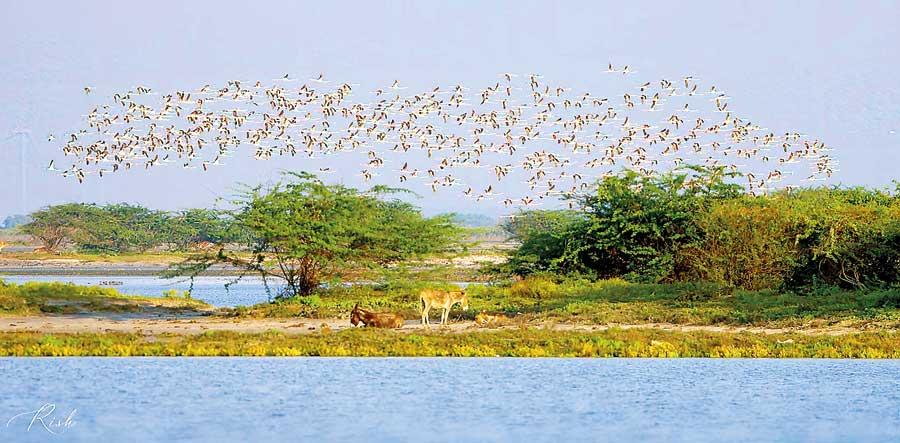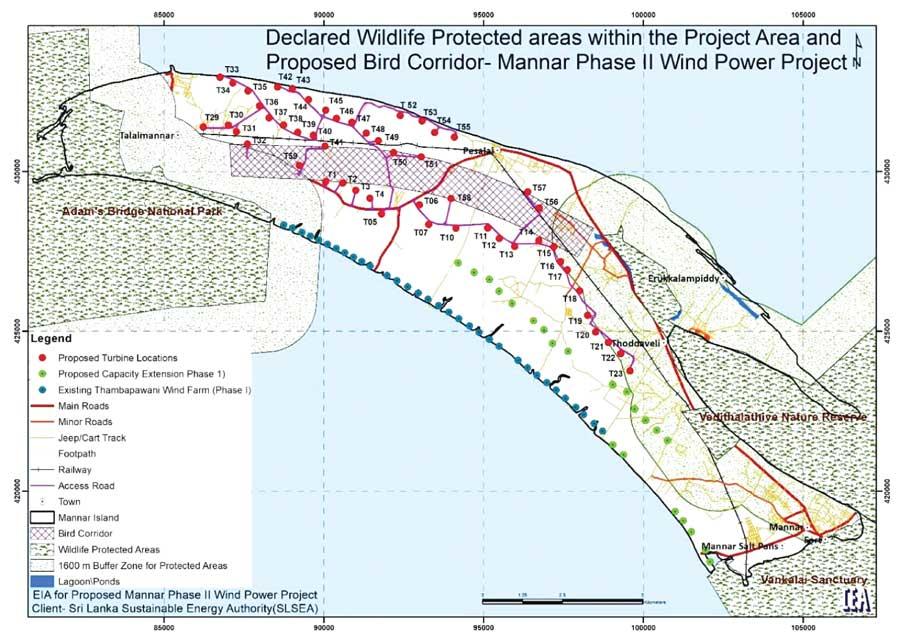Reply To:
Name - Reply Comment

Environmental groups warn that the proposed wind power project will destroy Mannar’s pristine ecosystems. Image courtesy - Dr. Rishani Gunasinghe
In February 2023, Adani Green Energy (Sri Lanka) Ltd was given provisional approval for two wind power projects of 250 MW in Mannar and 234 MW in Pooneryn. The proposed project site in Mannar spans across 250 acres of an environmentally sensitive location and environmental groups have expressed their concerns regarding the Environmental Impact Assessment (EIA) which is open for public comments till March 6. If the project in Mannar gets approved, around 50 turbines will be setup along one of the most important migratory bird corridors in the world, causing an irreversible ecological damage.
site in Mannar spans across 250 acres of an environmentally sensitive location and environmental groups have expressed their concerns regarding the Environmental Impact Assessment (EIA) which is open for public comments till March 6. If the project in Mannar gets approved, around 50 turbines will be setup along one of the most important migratory bird corridors in the world, causing an irreversible ecological damage.
Destroying a birding paradise
It is a known fact that Mannar attracts millions of migratory birds during the year including flamingos. For birders, the Central Asian Flyway - one of the eight global migratory highways is of particular importance as millions of birds fly via this route every year from north to south and vice versa. Shedding light on why Mannar shouldn’t be used the way it is going to be used for this project, Sampath Seneviratne, Professor of Zoology at the University of Colombo explained the behaviours of migratory bird species. “The migratory species breed in the Northern hemisphere, migrate to the south, remain for six months during winter and fly back. The Central Asia Flyway covers Eastern Europe all the way to far Eastern Russia. Mannar is in fact one of the main entry points and around a million birds remain there.
“Data from the e-bird citizen science platform shows that there’s a high density of birds in Mannar. The Asian Water Bird Survey shows that from 1937 to now there has been a stable presence of birds in Sri Lanka. The data shown have been obtained from one of the most technologically advanced studies conducted by the Colombo University, Chinese Academy of Sciences and several other institutions. Some bird species tagged from Mannar traverse the Himalayas, some 24,000 ft in the skies, all the way to Tibet, lay eggs there and return to Sri Lanka. This shows how Sri Lanka connects to the rest of the world and this evidence is based on futuristic sciences. Some birds spend 6 months in Pesalai, Urumalai, Vedithalathive,
|
Resident bird species found in Mannar |
Talaimannar, Vankalai and Mannar Town sometimes feeding off fish on fishing vessels. Birds from Mannar fly through India, Gujarat, Pakistan, Karachi, Afghanistan, Uzbekistan to Europe and Arctic, breed there and come back via Iran over the Arabic Sea to Mannar. They travel some 25,000km. One of the birds have travelled 70,000km over the past 3 years. When they go they tell us the humidity, temperature, places where they stop and we connect with global birders around the world.”
Prof. Seneviratne further said that another important area of concern is the Palk Bay which is a large wetland. “One part is in India and the other end is Sri Lanka and most migratory species spend a lot of time here. This is not just another place but a special place on the global map. We have been able to generate migratory maps of 22 individual species and Mannar has million more birds. A data point is being generated every half an hour indicating the flight of a bird. Some of these are globally endangered species while some are in fact the last remaining species on this planet. The project site of the proposed wind power project falls through the Adam’s Bridge Marine National Park,
Every half an hour there’s a data point generates and wherever they go we know day and night – globally endangered species – some of the last remaining species come here – rectangle represent the project site of Adani Green Energy – connectivity of wetlands in Mannar – Adam’s Bridge National Park – Puthukudirippu-Erukkalampiddy wetland, Vankalai Ramsar Sanctuary and Vedithalathive Nature Reserve,” he underscored.
A flawed EIA?
The Environment Impact Assessment (EIA) is now open for public comments. But legal experts have pointed out several grey areas in this document. Senior environmental lawyer Dr. Jagath Gunawardene said that usually an EIA is done under three broad laws; the National Environment Act (NEA), Coast conservation and coastal resource management Act and the Flora and Fauna Protection Ordinance (FFPO). “But in this case the EIA is done under the NEA and the project approving body is the CEA. The best way is to have two concurrent authorities, the project approving agency and the CEA, but like in many other instances the CEA is the sole project approving body. We have time till March 6 to express comments in writing and in addition we have asked for an oral submission for the comments we give in writing. Written comments have to be given by persons who wish to be heard on the hearing. We suggest that people in Mannar and in other parts of the country too are given a chance to submit oral submissions.”
People have the right to protect the environment as per the Constitution and it is applied equally to all citizens. He further said that Section 33 of the NEA states that an EIA is necessary for any project and it should have a detailed description of the project, environmental impacts of the project and suggestions to reduce the impacts. “It should also include the prevailing environmental conditions at the project site as well. Thirdly and most importantly, an EIA should mention other environmentally-less damaging alternatives and those drafting the EIA should indicate why they have discarded the environmentally-less damaging options and have opted for this alternative,” he added.
Dr. Gunawardana warned that the ultimate decision would be affected if they go by the existing EIA. “In this report these sections haven’t been included and therefore it is an incomplete
|
Megha - a Heuglin Gull |
report. The project approving authority evaluates the report but they don’t do the research. Their decisions depend on the quality and quantity of materials in the report. But if the report doesn’t include the truth, haven’t addressed issues carefully then the ultimate decision will be flawed.”
Some key factors haven’t been addressed. There is no analysis done on palm groves. There are three species of critically endangered bats in this area. But only one species is mentioned. There are over 200 bird species in Mannar but only a few are mentioned in the report. Then there are residential species in Mannar and there’s no indication of how their habitats would be impacted by the project.”
“Then what about the evaluation of alternatives? They have mentioned Ambewela as an alternative location but there’s no justification as to why they chose Mannar and why other places were not taken into account. There’s no logical reasoning. This is called Error in the face of reporting because the document itself is poorly documented. We expect a better environmentally-friendly alternative or proposals to minimize the impacts through an EIA. But if these aren’t included there’s no point in going forward.”
He further stressed on the suggestion to protect the birds by setting up a corridor. “We can’t advice where the birds can fly. So how can we be sure that these birds would fly from this proposed corridor? If the birds die they will say that the birds didn’t fly via the suggested corridor. Therefore a corridor is not a valid solution.”
Dr. Gunawardana further said that all migratory species are protected by the law. “We are part of the Biological Diversity Convention and therefore we are obliged to protect our biological diversity including migrant species. Irrespective of whether they are on land or sea we are obliged to protect these species. The Central Asian Flyway includes Mannar as well and there are international conventions to protect all migratory animals including the Convention on Migratory Species which has listed many species. The crab plover is one such species and they have a migratory route along the Central Asian Flyway. Migratory animals are not only birds. It includes butterflies and dragonflies as well. The report doesn’t mention about dragonflies or butterflies at all. These are some of the issues in this report. The EIA report should be adequate enough for the decision maker to take an informed decision but a report of this nature would lead to a flawed decision. From a legal point of view this report has disregarded many key points. We are under obligation to abide by international conventions and we cannot recommend a report or project that would undermine the obligations.”
Blindfolding in broad daylight?
In his analysis on the proposed generation of power narrated by the project owner, internationally acclaimed biodiversity scientist Dr. Rohan Pethiyagoda said that the proposed wind farm will generate 250 megawatts of power. “The EIA states that this is a low cost alternative when compared to other traditional power plants in the country. But over the years it has been observed that wind prices are at all time lows when compared to gas and solar. What we are going to pay Adani is 200 to 300 times more than global wind power prices. While global prices come down, we are obliged to pay this fixed rate for the next 25 years! According to the agreement, the Adani Wind Power project will take away an estimated USD 1250 million as foreign revenue from Sri Lanka; which in other words mean that we will have to purchase wind power at USD rates when in fact it is a natural resource that we already have.”
